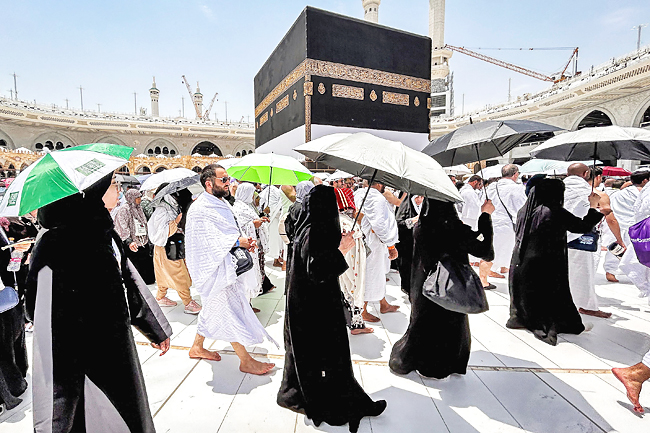MAKKAH (AFP) – From misting systems to heat-reflective road coverings, Saudi officials are trying to aid haj pilgrims in coping with heat, but scientists caution that climate change may outpace these efforts.
The annual pilgrimage, one of the world’s largest religious gatherings, coincides again this year with the hot Saudi summer, with officials predicting average highs of 44 degrees Celsius.
Travelling to Makkah from Chicago in the United States, Shariq Memon prepared for the worst, though he told AFP conditions had been manageable so far.
“We were told it would be very hot,” the 44-year-old said as he left the Grand Mosque this week.
“It’s hot, but somehow, with the spirit of Allah the Almighty, we don’t feel the heat that much.”
Heat mitigation measures implemented at the holy sites in recent years may also have something to do with it.

Near the Kaabah, the black cubic structure in the Grand Mosque towards which all Muslims pray, new air-conditioned spaces allow pilgrims to cool off, and a climate-controlled pathway now connects the hills of Safa and Marwah inside the mosque compound.
Since last year, roads used by the faithful have been covered in a white cooling material that Saudi officials say reduces the temperature of the asphalt by 20 per cent.
On top of that, volunteers distribute water and umbrellas and offer advice to pilgrims on avoiding hyperthermia, while misting systems and air-conditioned shopping malls provide temporary relief between prayers.
Yet officials have few options to alleviate certain stages of the haj, notably yesterday’s day-long prayers under the blazing sun on Mount Arafah.
As he waited ahead of Friday’s formal start of the haj, Memon said he was not worried.
“I am a very easy-going guy, so I didn’t take any measures. My wife has done a lot of measures,” he said, citing the rehydration solution she packed in his suitcase.
“I don’t know. I will just follow her.”
The pilgrimage, which takes most people at least five days to complete, is a “marathon”, said spokesperson for the Saudi health ministry Mohammed al-Abdulali.
Pilgrims, especially those who are elderly or have health issues, “are exposed to the risk of exhaustion or heat stroke, which are dangerous”, he said.
Last year more than 10,000 cases of heat-related illnesses were documented, 10 per cent of which were heat stroke, he said.
Abdulali said there were at least some deaths connected to heat stress in 2023 “but their number was limited” because of rapid interventions taken by medical teams and their experience “acquired over decades”.
The timing of the haj is determined by the Islamic lunar calendar, and years in which it takes place during summer have long brought high numbers of heat stress cases, according to a study published last month by the King Faisal Specialist Hospital and Research Centre based in Riyadh.
In 1987, for example, about 1,000 pilgrims died from heat-related conditions, the study said.
But in the past 40 years, thanks to “mitigation measures”, incidents of heat stress have fallen by 74.6 per cent and the mortality rate from these cases has fallen by 47.6 per cent, it said.
The same study notes, however, that temperatures in the region are rising by 0.4 degrees Celsius per decade.
“Worsening heat may be outpacing the comprehensive mitigation strategies in place,” it said.
Distributing water and installing misting systems “will not be enough” to adapt, said Fahad Saeed of Climate Analytics, an institute based in Germany.
If conditions worsen, he said, there is a risk that “we are going to lose some of the rituals” seen as essential to the pilgrimage.





